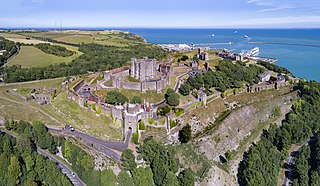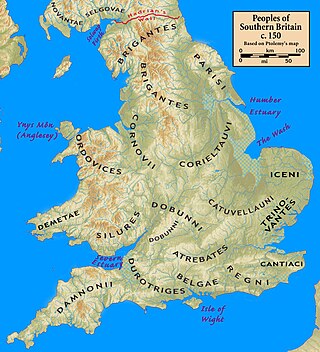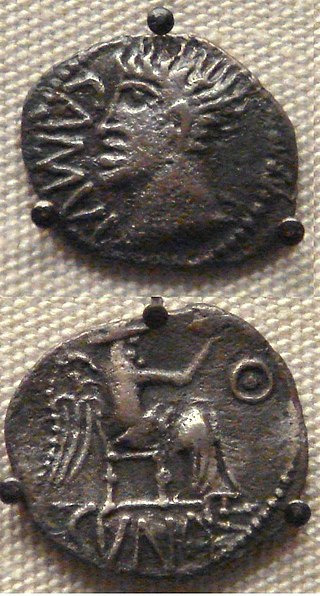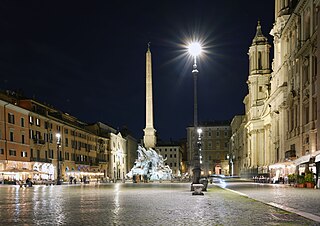
Invicta is a Latin word meaning invincible, undefeated, or unconquered. It has been used in mottoes like Roma invicta (Latin for "Unconquered Rome"), and it is the motto of the county of Kent, England. [1]

Invicta is a Latin word meaning invincible, undefeated, or unconquered. It has been used in mottoes like Roma invicta (Latin for "Unconquered Rome"), and it is the motto of the county of Kent, England. [1]
"Invicta" has been a motto for centuries. Roma invicta is a Latin phrase, meaning "Unconquered Rome", inscribed on a statue in Rome.[ which? ] It was an inspirational motto used until the fall of the Western Roman Empire in 476 AD. This symbolic statement was later printed onto gold coins, to help boost the morale of the failing Empire.
For Kent, it dates back to the invasion of England by Duke William of Normandy in the year 1066. As the official motto, it appears on the coat of arms of Kent County Council.
Leaving the battle site at Hastings, William marched on to London on his way to the (then) capital Winchester. While passing through Kent, the local people attacked and harassed William's men. The uncertain William and his army fled and went a different route to London. As the people of Kent had chased William away, they adopted "Invicta" as a county motto. [2]

A different version of the legend above is depicted on a monument at Swanscombe, where legend states this meeting took place on the Old Roman Road to London (Watling Street). The monument, sculpted by Hilary Stratton and unveiled in 1958, was moved in the early 1960s due to the construction of the A2 dual carriageway. It is now located in the churchyard of St Peter and St Paul's Church in Swanscombe, where the picture (right) was taken.
The monument states that:
Near this spot by ancient tradition the men of Kent and Kentish men carrying boughs on their shoulders and swords in their hands met the invader William Duke of Normandy. They offered peace if he would grant their ancient rights and liberties otherwise war and that most deadly. Their request was granted and from that day the motto of Kent has been INVICTA meaning Unconquered.
Because Dover and Kent were not besieged or defeated on William's march, but instead the people demanded and received preservation of their rights in exchange for acknowledging his kingship and peace, they were therefore not conquered by him. Holding of land in Kent by gavelkind, rather than the Norman laws of primogeniture, lasted until the early-20th century suggesting that the people of Kent were successful in maintaining their rights. [3] [4] [5]
As the motto of the county, "Invicta" is now a frequently used term within Kent.[ citation needed ]
"Cidade Invicta" ("Unvanquished City") is coined of the city of Porto, Portugal. It was earned during the Napoleonic invasions in the 19th century.

The Jutes were one of the Germanic tribes who settled in Great Britain after the departure of the Romans. According to Bede, they were one of the three most powerful Germanic nations, along with the Angles and the Saxons:
Those who came over were of the three most powerful nations of Germany—Saxons, Angles, and Jutes. From the Jutes are descended the people of Kent, and of the Isle of Wight, and those also in the province of the West Saxons who are to this day called Jutes, seated opposite to the Isle of Wight.

Kent is a county in the South East England region, the closest county to continental Europe. It borders Essex across the entire estuary of the River Thames to the north; the French department of Pas-de-Calais across the Strait of Dover to the south-east; East Sussex to the south-west; Surrey to the west and Greater London to the north-west. The county town is Maidstone.

The Battle of the Milvian Bridge took place between the Roman Emperors Constantine I and Maxentius on 28 October AD 312. It takes its name from the Milvian Bridge, an important route over the Tiber. Constantine won the battle and started on the path that led him to end the Tetrarchy and become the sole ruler of the Roman Empire. Maxentius drowned in the Tiber during the battle; his body was later taken from the river and decapitated, and his head was paraded through the streets of Rome on the day following the battle before being taken to Africa.

In Roman religion, the genius is the individual instance of a general divine nature that is present in every individual person, place, or thing. Much like a guardian angel, the genius would follow each man from the hour of his birth until the day he died. For women, it was the Juno spirit that would accompany each of them.

In ancient Roman religion, Roma was a female deity who personified the city of Rome and, more broadly, the Roman state. She was created and promoted to represent and propagate certain of Rome's ideas about itself, and to justify its rule. She was portrayed on coins, sculptures, architectural designs, and at official games and festivals. Images of Roma had elements in common with other goddesses, such as Rome's Minerva, her Greek equivalent Athena and various manifestations of Greek Tyche, who protected Greek city-states; among these, Roma stands dominant, over piled weapons that represent her conquests, and promising protection to the obedient. Her "Amazonian" iconography shows her "manly virtue" (virtus) as fierce mother of a warrior race, augmenting rather than replacing local goddesses. On some coinage of the Roman Imperial era, she is shown as a serene advisor, partner and protector of ruling emperors. In Rome, the Emperor Hadrian built and dedicated a gigantic temple to her as Roma Aeterna, and to Venus Felix, emphasising the sacred, universal and eternal nature of the empire.

A fief was a central element in medieval contracts based on feudal law. It consisted of a form of property holding or other rights granted by an overlord to a vassal, who held it in fealty or "in fee" in return for a form of feudal allegiance, services or payments. The fees were often lands, land revenue or revenue-producing real property like a watermill, held in feudal land tenure: these are typically known as fiefs or fiefdoms. However, not only land but anything of value could be held in fee, including governmental office, rights of exploitation such as hunting, fishing or felling trees, monopolies in trade, money rents and tax farms. There never existed a standard feudal system, nor did there exist only one type of fief. Over the ages, depending on the region, there was a broad variety of customs using the same basic legal principles in many variations.

SPQR or S.P.Q.R. an initialism for Senatus Populusque Romanus, is an emblematic phrase referring to the government of the Roman Republic. It appears on documents made public by an inscription in stone or metal, in dedications of monuments and public works, and on some Roman currency.

Dover Castle is a medieval castle in Dover, Kent, England and is Grade I listed. It was founded in the 11th century and has been described as the "Key to England" due to its defensive significance throughout history. Some writers say it is the largest castle in England, a title also claimed by Windsor Castle.

The Regni were a Celtic tribe or group of tribes living in Britain prior to the Roman Conquest, and later a civitas or canton of Roman Britain. They lived in what is now Sussex, as well as small parts of Hampshire, Surrey and Kent, with their tribal heartland at Noviomagus Reginorum.

Cunobeline or Cunobelin, also known by his name's Latin form Cunobelinus, was a king in pre-Roman Britain from about AD 9 to about AD 40. He is mentioned in passing by the classical historians Suetonius and Dio Cassius, and many coins bearing his inscription have been found. He controlled a substantial portion of south-eastern Britain, including the territories of the Catuvellauni and the Trinovantes, and is called "King of the Britons" by Suetonius. Cunobeline may have been a client king of Rome, based on the images and legends appearing on his coins. Cunobeline appears in British legend as Cynfelyn (Welsh), Kymbelinus or Cymbeline, as in the play by William Shakespeare.

Piazza Navona is a public open space in Rome, Italy. It is built on the site of the 1st century AD Stadium of Domitian and follows the form of the open space of the stadium in an elongated oval. The ancient Romans went there to watch the agones ("games"), and hence it was known as "Circus Agonalis". It is believed that over time the name changed to in avone to navone and eventually to navona.

Gavelkind was a system of land tenure chiefly associated with the Celtic law in Ireland and Wales and with the legal traditions of the English county of Kent.

Swanscombe /ˈswɒnzkəm/ is a village in the Borough of Dartford in Kent, England, and the civil parish of Swanscombe and Greenhithe. It is 4.4 miles west of Gravesend and 4.8 miles east of Dartford.

Kent is a traditional county in South East England with long-established human occupation.

Dulce et decorum est pro patria mori is a line from the Odes (III.2.13) by the Roman lyric poet Horace. The line translates: "It is sweet and proper to die for one's country." The Latin word patria (homeland), literally meaning the country of one's fathers or ancestors, is the source of the French word for a country, patrie, and of the English word "patriot".

Roma invicta is a Latin phrase, meaning "unconquered Rome". It was an inspirational motto used until the Fall of the Western Roman Empire in 476 AD. This symbolic statement was later printed onto gold coins.

The white horse of Kent, known colloquially as the white horse rampant, is a symbol of the county of Kent, in south-east England. The heraldic image is correctly blazoned as Gules, a stallion forcené argent.
Invictus may refer to:

The Temple of Jupiter Feretrius was, according to legend, the first temple ever built in Rome. Its site is uncertain but is thought to have been on the Capitoline Hill.

The Temple of Isis and Serapis was a double temple in Rome dedicated to the Egyptian deities Isis and Serapis on the Campus Martius, directly to the east of the Saepta Julia. The temple to Isis, the Iseum Campense, stood across a plaza from the Serapeum dedicated to Serapis. The remains of the Temple of Serapis now lie under the church of Santo Stefano del Cacco, and the Temple of Isis lay north of it, just east of Santa Maria sopra Minerva. Both temples were made up of a combination of Egyptian and Hellenistic architectural styles. Much of the artwork decorating the temples used motifs evoking Egypt, and they contained several genuinely Egyptian objects, such as couples of obelisks in red or pink granite from Syene.